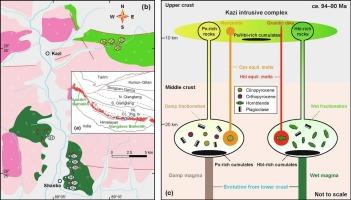IF 7.2
1区 地球科学
Q1 GEOSCIENCES, MULTIDISCIPLINARY
引用次数: 0
摘要
幔源岩浆的分离结晶作用是大陆地壳化学分层形成的有效机制。然而,当缺少互补的堆积岩时,确定这样的机制是一个挑战。锆石U-Pb测年表明,卡子杂岩形成于94 ~ 90 Ma。角闪石辉长岩含角闪石同心分带结晶,二长岩含角闪石斜辉石包裹体结晶。矿物地温压指示卡子杂岩的母岩浆首先在中地壳部分结晶,然后在上地壳侵位。全岩主微量元素组成以及与斜长石早期结晶平衡的熔体元素组成表明,二长岩经历了斜长石和斜长石分馏作用。角闪石辉长岩产出的计算熔体主微量元素组成与早期结晶角闪石平衡,与相邻的埃达克质花岗岩脉相似,表明角闪石-熔体在其代中分离。这些特征和各岩性相似的贫锆石Hf同位素组成表明,喀子杂岩的形成主要受中地壳湿岩浆和湿岩浆分选作用的控制,冈底斯基晚白垩世部分花岗岩脉的易达质地球化学特征可能受角闪石为主的弧岩浆分选作用的控制。本文章由计算机程序翻译,如有差异,请以英文原文为准。

Coexisting wet and damp magma fractionation in the middle crust: An example from the Gangdese Batholith in southern Tibet
Fractional crystallization of mantle-derived magmas is an effective mechanism for developing the chemical stratification of the continental crust at convergent plate margins. However, identifying such a mechanism is a challenge when the complementary cumulate rocks are missing. To address this issue, we present geochronological, mineral chemical, whole-rock geochemical, and zircon Hf isotopic data for the Kazi intrusive complex (hornblende gabbro and monzonite) in the Gangdese Batholith, southern Tibet. Zircon U–Pb dating shows that the Kazi complex formed at 94–90 Ma. The hornblende gabbro contains hornblende crystals with concentric zoning and the monzonite contains hornblende crystals with clinopyroxene inclusions. Mineral-based geothermobarometers indicate that the parental magmas of the Kazi complex first partially crystallized in the middle crust before being emplaced in the upper crust. Whole-rock major and trace element compositions, as well as those of calculated melts in equilibrium with early crystallized clinopyroxenes, reveal that the monzonites experienced clinopyroxene and plagioclase fractionation. The hornblende gabbros yield calculated melt major and trace element compositions in equilibrium with early crystallized hornblendes that are similar to those of adjacent adakitic granitic dikes, indicative of hornblende–melt separation in their generation. These features and the similar depleted zircon Hf isotopic compositions of the various lithologies show that formation of the Kazi complex was controlled primarily by coexisting wet and damp magma fractionation in the middle crust, and that the adakitic geochemical characteristics of some Late Cretaceous granitic dikes in the Gangdese Batholith could be due to hornblende-dominated fractionation of arc magmas.
求助全文
通过发布文献求助,成功后即可免费获取论文全文。
去求助
来源期刊

Gondwana Research
地学-地球科学综合
CiteScore
12.90
自引率
6.60%
发文量
298
审稿时长
65 days
期刊介绍:
Gondwana Research (GR) is an International Journal aimed to promote high quality research publications on all topics related to solid Earth, particularly with reference to the origin and evolution of continents, continental assemblies and their resources. GR is an "all earth science" journal with no restrictions on geological time, terrane or theme and covers a wide spectrum of topics in geosciences such as geology, geomorphology, palaeontology, structure, petrology, geochemistry, stable isotopes, geochronology, economic geology, exploration geology, engineering geology, geophysics, and environmental geology among other themes, and provides an appropriate forum to integrate studies from different disciplines and different terrains. In addition to regular articles and thematic issues, the journal invites high profile state-of-the-art reviews on thrust area topics for its column, ''GR FOCUS''. Focus articles include short biographies and photographs of the authors. Short articles (within ten printed pages) for rapid publication reporting important discoveries or innovative models of global interest will be considered under the category ''GR LETTERS''.
 求助内容:
求助内容: 应助结果提醒方式:
应助结果提醒方式:


